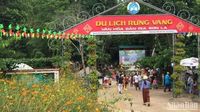The travel landscape in Vietnam is shifting dramatically as the nation anticipates a vibrant tourism year in 2025, driven by changing consumer preferences and economic pressures. As international tourism surged almost 39% in 2024, the industry is preparing for an even more robust visitor season, thanks to both domestic and international tourists.
In 2024, Vietnam welcomed nearly 17.5 million international visitors, up 38.9% from 2023, while domestic tourism reached an estimated 110 million, reflecting a modest 1.6% increase. The total revenue generated from these tourists was approximately 840 trillion VND, marking a 23.8% rise from the previous year. Nguyen Anh Tuan, Director of the Vietnam Institute for Tourism Development Research, highlighted the optimistic trends for 2025, stating, “The positive results of 2024 open up great prospects for 2025.” He emphasized a significant jump in visitor numbers during the first two months of 2025, reinforcing the anticipation of thriving tourism ahead.
According to Tuan, domestic tourism is expected to continue as the main growth driver. An emerging trend among travelers is high-end experiential travel; tourists are increasingly willing to spend more for quality services instead of merely seeking budget options. Vietnam's tourism scene is also witnessing the rise of multi-generational travel, which families are embracing to strengthen connections and create lasting memories.
Innovations in technology and artificial intelligence are becoming pivotal in enhancing travel experiences. These tools not only help design personalized travel itineraries but also enrich convenience for tourists. Associate Professor Dr. Pham Hong Long, head of the Faculty of Tourism at the University of Social Sciences and Humanities, observed, “Tourists increasingly focus on personalized experiences instead of just sightseeing.” He indicated a marked rise in interest in health tourism, cultural, and culinary experiences that go beyond the conventional.
While the upward trajectory of tourism appears promising, the industry must navigate the realities of economic fluctuations. The effects of inflation and rising costs are already influencing spending behaviors. As Tran Thi Kim Qui, Deputy General Director of FLC Hotels & Resorts, remarked, “We are implementing many important strategies to meet the diverse needs of customers during the price storm.” The company is committed to enhancing service quality and diversifying its offerings, including all-inclusive vacation packages, to attract the evolving customer base.
FLC Hotels & Resorts is making notable strides in this area by implementing flight and rail combo packages, including a unique “0 VND” rail travel experience to popular destinations like Quy Nhon. This combination aims to provide flexibility and affordability while maintaining high standards.
On the ground, travel agencies are adapting to the evolving demands of domestic travelers. Saigontourist's Hanoi branch, directed by Nguyen Hoai Thu, anticipates a surge in interest for domestic travel in 2025. She highlighted the importance of products showcasing local culture and culinary delights, stating, “Saigontourist Travel focuses on products that deploy unique experiences of local culture as well as delicious local dishes to elevate the Vietnamese brand on the world map.”
Amid rising tourism, experts have cautioned that travelers need to remain vigilant against potential scams. Thu advised tourists to engage reputable travel agencies and utilize comprehensive insurance packages to secure their trips.
In addition to traditional travel models, a recent survey conducted by Vietravel, a travel agency in Thanh Hoa province, found that a significant majority of young tourists—aged 15 to 30—are expressing a keen interest in innovative travel trends. Many are drawn toward eco-tourism, beach resorts, and glamping. Tran Thi Nga, Director of Vietravel's Thanh Hoa branch, stated, “The demand for exploring new travel trends among young people is increasing in recent years.” Furthermore, about 65-70% of these young customers prefer tours lasting from 2 days to a full week, demonstrating a desire for deep engagement rather than superficial excursions.
Various destinations, including Bai Dong and Anh Phat Hotels & Resorts, have adapted to these new preferences, offering cultural immersion and adventure opportunities. These locations now see up to 70% of their visitors as young travelers, a demographic that is reshaping Vietnam’s tourist profile.
Moreover, as more young travelers gravitate towards experiences that offer cultural and historical insights, local entities like museums are also pressured to innovate. Trinh Dinh Duong, director of the Thanh Hoa Provincial Museum, remarked that experiences tied to local culture and history are in high demand among youth who seek meaningful interactions during their travels.
With advancing technology, solo travel and group trips have become more prevalent among youth, as they increasingly self-organize their travel arrangements through available apps or direct bookings. This trend reflects a more independent approach to travel, prompting businesses to consider how best to attract and engage this savvy demographic who demand not only affordability but also unique and fulfilling experiences.
As Vietnam gears up for what promises to be a transformative 2025 in tourism, the capabilities of businesses to meet the evolving preferences of travelers will dictate their success in a rapidly changing landscape. While challenges remain, the proactive strategies across the tourism sector signal a readiness to adapt to the future.


